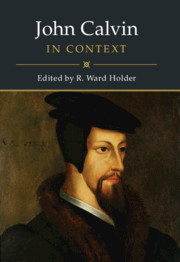Book contents
- John Calvin in Context
- John Calvin in Context
- Copyright page
- Dedication
- Contents
- Contributors
- Acknowledgments
- Abbreviations
- Introduction
- Part I France and Its Influence
- Part II Switzerland, Southern Germany, and Geneva
- Part III Empire and Society
- Part IV The Religious Question
- Part V Calvin’s Influences
- Part VI Calvin’s Reception
- Conclusion
- Bibliography
- Index
Conclusion
Calvin and Calvinism: A Variety of Portraits
Published online by Cambridge University Press: 14 November 2019
- John Calvin in Context
- John Calvin in Context
- Copyright page
- Dedication
- Contents
- Contributors
- Acknowledgments
- Abbreviations
- Introduction
- Part I France and Its Influence
- Part II Switzerland, Southern Germany, and Geneva
- Part III Empire and Society
- Part IV The Religious Question
- Part V Calvin’s Influences
- Part VI Calvin’s Reception
- Conclusion
- Bibliography
- Index
Summary
William Bouwsma, the celebrated intellectual historian, published his John Calvin: A Sixteenth Century Portrait, in 1987.1 That probing analysis did not seek so much to write a complete biography of John Calvin as to understand him and the modern world that, in Bouwsma’s estimation, had ignored Calvin.2 As an intellectual historian, Bouwsma turned to the evidence from Calvin’s own writings, and found him to be suspended between the labyrinth and the abyss.3 Bouwsma believed that getting to the intellectual character of Calvin would provide a better portrait, and grant the modern world a view of a figure who had left an indelible mark on the mind of the modern Christian world. The depth and breadth of response within the small group of professional Calvin scholars to Bouwsma’s book suggested that, at the very least, he had touched a nerve – and that nerve was not within Calvin, but within those who could broadly be called Calvinists.
- Type
- Chapter
- Information
- John Calvin in Context , pp. 436 - 437Publisher: Cambridge University PressPrint publication year: 2019

